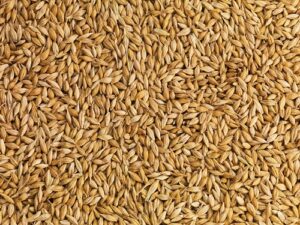Barley Comes up the Backstretch

This article written by Dr. Reynold Bergen, BCRC Science Director, originally appeared in the February 2020 issue of Canadian Cattlemen magazine and is reprinted on the BCRC Blog with permission of the publisher.
Like cattle performance, crop yields reflect the interplay between genetics, management practices and environmental conditions. Statistics Canada reports show that barley yields weren’t keeping up with other feed crops for decades. Barley yields increased 0.39 bushels/acre/year between 1980 and 2009, slower than either wheat (0.44) or corn (1.66). But since 2010, Canada’s barley yields have improved faster (1.32) than both wheat (0.84) and corn (0.66). This apparent tripling of barley yield gains is remarkable, especially considering that canola, corn and wheat development receive tremendous research investment, and their expanding acreages have squeezed barley’s shrinking acres onto less productive farmland.
Canada’s beef industry can share some credit for barley’s improved performance. Alberta Beef Producers, Alberta Cattle Feeders’ Association and the Beef Cattle Research Council have supported Alberta Agriculture’s Field Crop Development Center, where Dr. Flavio Capettini leads Canada’s only dedicated feed and forage barley breeding program. This team’s work under the 2013-18 Beef Science Cluster illustrates how much effort it takes to breed a new, improved feed grain variety.
What They Did:
First, the team crossed barley genetics from Canada, France, US, Mexico, Argentina, Uruguay, Brazil, Syria and other countries to introduce new, favorable genes. A ‘fast breeding’ technique using field plots in summer and growth rooms, chambers and sites in California in the fall and winter allowed them to grow multiple generations per year. After eight generations, the best new lines were grown in test plots across Canada. These tests emphasized yield, lodging and disease resistance, but also measured grain, feed, malt and forage quality. Some lines were also grown in international “hot spots” for diseases like Fusarium Head Blight. The most promising lines then underwent two years of Prairie Grain Development Committee Co-op trials, which determine which varieties are recommended for registration.
What They Learned:
Compared to conventional approaches, the ‘fast breeding’ approach shortened the breeding cycle from six years to 3.5 years and shaved at least three years off the time needed to produce a new variety. A companion project used genomic marker panels to evaluate disease resistance and fiber digestibility. With further development and validation, genomic markers will allow even more rapid and accurate identification of promising barley lines.
Plant breeding is not for the faint of heart. For example, the 900 original crosses produced 95,000 separate lines that were evaluated in the initial ‘fast breeding’ steps. Of these, 4,258 selected lines entered the yield tests, 77 survived to enter the Co-op trials, 13 were recommended for registration, and 6 new varieties were commercialized.
What it Means:
Beef producers and government funders don’t always understand why they need to support barley breeding, especially when private companies breed corn and canola. But these are fundamentally different crops. Corn and canola are open-pollinated crops, meaning that one plant is naturally pollinated by a second plant. It’s relatively straightforward to take two high-yielding lines of corn and cross them to produce an even higher-yielding and very uniform hybrid “F1” crop. But if the seed from the F1 crop is saved and re-planted, the next “F2” crop will be a horrible hodgepodge of large cobs and small cobs and everything in between. This means corn growers need to go back to the companies for new seed each year. The guaranteed market for new seed gives corn and canola breeding companies the confidence and incentive to develop new and better varieties.
It is much harder to make hybrid varieties using self-pollinated crops like barley, and even harder to get a hybrid barley that outperforms both parental strains. This means new barley varieties don’t get the regular yield boost that is common with new corn or canola hybrids. Farmers can also re-plant saved seed to grow the next barley crop without a significant loss in yield or uniformity. Barley is critical where the growing season is too short, cool or dry for corn. That’s a relatively small-acreage in Western Canada, northern Ontario and the northern US. Most livestock producers elsewhere feed corn. If you were a genetics company choosing between breeding seed for a large, high-value crop with virtually guaranteed repeat customers, or a small-acreage, low-value crop that your customer can save and re-sow… which would you choose?
We can’t simply leave barley development to the malt barley breeders, either. A lot of malt barley does end up as feed. But malt barley needs to balance many more traits (not just yield and lodging and disease resistance, but also malt quality traits like fine extract, diastatic power, alpha amylase, malt β-glucan, malt protein, soluble malt protein, free amino nitrogen, homogeneity, turbidity, Kolbach index, friability, and skinning potential) in their breeding program. Selecting for more traits makes the breeding process more complex and slows genetic progress. On top of that, a great malt barley may not always make a great feed barley, especially in terms of protein content.
Barley breeding is another example of why governments and industry groups need to invest in research and development – to support innovations that are too risky or not profitable enough to attract private investment, but that are critical to our industry’s international competitiveness.
The Beef Research Cluster is funded by the Canadian Beef Cattle Check-Off and Agriculture and Agri-Food Canada with additional contributions from provincial beef industry groups and governments to advance research and technology transfer supporting the Canadian beef industry’s vision to be recognized as a preferred supplier of healthy, high quality beef, cattle and genetics.
Click here to subscribe to the BCRC Blog and receive email notifications when new content is posted.
The sharing or reprinting of BCRC Blog articles is typically welcome and encouraged, however this article requires permission of the original publisher.
We welcome your questions, comments and suggestions. Contact us directly or generate public discussion by posting your thoughts below.